Smarter, Safer Hot Water: Digital Thermostatic Mixing Stations
Specifying digital mixing and recirculation stations provide a sustainable measurement and verification system that conserves water, saves energy, protects users from hot water burns, and helps minimize the occurrence of Legionella in tempered water delivery systems
Sponsored by Powers and WATTS Water Technologies, Inc. | Celeste Allen Novak FAIA, LEED AP BD+C
A rise in the number of people scalded in public buildings from hot water, the increase in Legionnaires’ disease and the demands for water conservation are challenges that designers face when specifying water mixing and circulation systems. The plumbing system is the one component of buildings that directly affects public health. There are many challenges when considering the overall integration of internal systems in sustainable high-performance buildings. Today, engineers, designers, and facility managers have new tools to directly measure, monitor, and deliver safer hot water systems due to new digital advances in hot water mixing and recirculation systems in commercial and institutional buildings.
The health statistics are alarming. According to the American Society of Sanitary Engineering (ASSE), burn injuries can occur at temperatures above 120 degrees F. Most codes recommend that all of the components of a hot water delivery system be set at temperatures that prevent hot water burns. However, the codes do not require consistent hot water temperatures throughout building water systems. There can be wide fluctuations in hot water temperatures supplied to any plumbing fixture, such as a shower or handwashing faucet, resulting in unsafe conditions and potential liabilities. Entire systems are engineered with a complex system of pipes, valves, and thermostats which until recently were based on analog, not digital, elements.
Hot water temperatures can vary widely throughout most building plumbing systems causing uneven and dangerous temperature swings. As one example, a survey of major hotel chains was conducted to review the temperatures in their hot water system at showerheads and faucets. Very hot water was found in 91 percent of the first 100 rooms tested even though the design of these systems met current codes and used the latest in pressure-balanced valves. These hotel rooms delivered maximum hot water temperatures for showers in excess of 115 degrees F while 78 percent provided water in excess of 120 degrees F. At 120 degrees F, it takes more than five minutes to produce a first-degree burn. At 140 degrees F, it takes approximately five seconds to sustain a first-degree burn, creating an enormous safety and liability problem for owners and operators. The thermal shock of a rapid and uncomfortable change in shower temperature can cause a fall or serious injury. For hotel owners, maximizing temperature controls and temperature swings will decrease their liability.

Photo courtesy of Powers, a Watts brand
A digital mixing and recirculation station provides safer hot water delivery in commercial and institutional buildings.
In addition, the temperatures in 62 percent of the surveyed rooms had hot water that was set at the prime temperature for the growth of the bacteria Legionella Pneumonia. According to the Centers for Disease Control (CDC), an estimated 8,000 to 18,000 people are hospitalized with Legionnaires’ disease each year in the U.S. Inhalation of aerosols or mists containing the bacterium is presumed to be the primary means of acquiring legionellosis. Aerosolized waters from cooling towers, evaporative condensers, showers, and humidifiers have been identified as sources of infection.
The ideal temperature for the growth of Legionella is between 95 and 115 degrees F, the same temperatures that are safest to prevent scalding from hot water. In order to safeguard the public from this deadly bacteria, water temperatures must be high enough at the point of source to prevent bacterial growth and low enough to prevent scalding at point-of-use.
“When it comes to Legionella bacteria, outbreaks occur when two or more people become ill in the same place at about the same time, such as patients in hospitals. Hospital buildings have complex water systems, and many people in hospitals already have illnesses that increase their risk for Legionella infection. Other outbreaks have been linked to aerosol (mist) sources in the community or with cruise ships and hotels, with the most likely sources being hot tubs, cooling towers (air-conditioning units from large buildings), and water used for drinking and showering.” To prevent the build up of the Legionella bacteria, Occupational Safety & Health Administration (OSHA) recommends that water systems be properly inspected and maintained with frequent flushing of domestic water systems at very high temperatures.
Along with medical professionals, the design profession is committed to ethically protect the health, safety, and welfare of the public. Designing buildings that heal, not harm, is an ethical mandate for all building professionals. The challenge to designers is that the control of both the prevention of scalding as well as the control of bacteria requires mechanical precision within a water distribution system. However, until recently, hot water delivery systems have been engineered using twentieth century components and engineering. New digital mixing and recirculation systems are smart water delivery solutions for mixing domestic water in a hot water recirculation loop. These systems are used in commercial and institutional facilities and can be integrated into a building automation system (BAS).
The digital revolution in building systems has created numerous new products that provide energy savings for high-performance building materials. BAS systems commonly control heating, ventilation, and air-conditioning systems (HVAC) and some larger equipment such as chillers and boilers. The latest in plumbing system design provides an opportunity for digital controls that can communicate to BAS programs. New digital mixing and recirculation stations allow for the integration of hot water delivery systems into automated program controls. A change from mechanical to digital equipment is a welcome advance in technology. These new mixing stations control the entire tempered water recirculation loop at safe temperatures using electronic mixing valves, fast response sensors, and high-speed actuation. They can limit temperature regulation to exceed the requirements of the American Society of Inspectors of Plumbing and Sanitary Engineers, ASSE 1017. This standard allows mixed outlet temperature swings within +/- 7 degrees F (for valves > 40 gpm) throughout a hot water system. Using high-performance digital valves, the new systems can reduce that temperature swing within +/-2 degrees F. This provides a control measure as well as energy savings that are difficult, if not impossible, to meet in mechanical systems.

Image courtesy of Powers, a Watts brand
Digital plumbing equipment can also deliver one of the first means to provide measurement and verification (M&V) commissioning data for the use of water in buildings through building automation systems. This advance in building commissioning systems provides a new tool to help conserve water as well as save energy.
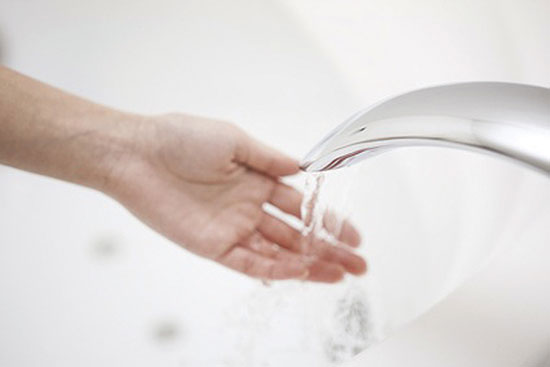
Photo courtesy of Powers, a Watts brand
A digital water mixing and recirculation station can adjust the volatile flow of hot and cold water in hotel rooms preventing burns.
Water and energy systems are interdependent. The U.S. Energy Information Administration (EIA) reported that in 2009, heating and cooling were no longer the culprits for high energy bills. Instead, water heating accounts for up to 18 percent of a home’s energy budget. In April 2015, data released by the EIA Commercial Buildings Energy Consumption Survey (CBECS) demonstrates that water heating accounts for a major factor in a commercial building’s energy budget comparable to that used for heating and cooling. Even minor changes in temperature control can mean major changes in overall cost savings.
E Source, a company originally part of the Rocky Mountain Institute, reports on research and provides data to utilities and other energy services as part of demand side management by utilities. Data from an E Source report on hospitals shows that water heating can consume as much as 35 percent of a total energy budget. Hot water heating is as much as one-third of most residential heating budgets.
As architects grow in their knowledge of how to deliver buildings that are both energy efficient as well as those that conserve water, details matter. Understanding the complex hot water system will provide tools that assist design professionals to develop more sustainable buildings. Digital advances in plumbing technology include new digital water mixing and recirculation systems for commercial and institutional buildings as part of a hot water regulating “plug and play” commercial boiler system. These units have simplified some of the uncertainties and challenges of safe hot water delivery by controlling large temperature swings and increasing the speed of response to temperature changes. They also can be connected by smart controllers to building automation systems that allow facility operators to measure and verify water and energy usage. These new units can be specified for new construction as well as for renovating existing buildings.
Green Building Ratings And Water Delivery Systems
Many green building rating systems focus on water conservation. New advances in digital technology for metering and monitoring are now allowing architects to combine credits to achieve even higher ratings and deliver greater water and energy savings. The new USGBC LEED v4 Integrative Process is a credit based on the concept that buildings are an organism with interrelated components. The Integrative Process Credit BD+C can be applied to the following building and construction types:
- New Construction
- Core & Shell
- Schools
- Retail
- Data Centers
- Warehouses & Distribution Centers
- Hospitality
- Healthcare
The intent of this credit is to support high-performance, cost-effective project outcomes through an early analysis of the interrelationships among systems. This credit involves an initial analysis of the site, water, energy, and materials as a first planning step—even prior to a green charrette.
To obtain this credit, the designer must perform a preliminary energy and water budget before the completion of schematic design. In accordance with the LEED v4 WE2 Prerequisite Indoor Water Use Reduction Credit, designers analyze the indoor water demand. A new indoor water use calculator is available through the USGBC that is part of the prerequisite for indoor water use. Design professionals must complete the Indoor Water Use Calculator for LEED v4 BD+C and ID+C WE Prerequisite Indoor Water Use Reduction. They are required to determine the water flow. They are also required to determine the flush, fixture, and case demand volumes. One option includes the metering of fixtures and fittings, and collecting meter data for one year to establish a water-use baseline. The overall goal is to reduce the use of potable water. However, until the onset of building automation systems and new BAS meters that can measure water use, the actual use of a building’s water system has been difficult, if not impossible, to document.
The ability to reduce the amount of boiler hot water sent through potable water lines through digital thermostatic mixing and recirculation stations is a new tool in the movement to reduce the use of heated hot water through potable hot water lines. These mixing valves can be regulated off-site, through BAS systems to maximize output and reduce unnecessary heating at the boiler source.
Architects are encouraged in this new credit to integrate numerous strategies, such as the combination of the new LEED v4 credit with EA Credit 5 Measurement and Verification, for a detailed post-occupancy review.
New digital water mixing and recirculation stations are now available to monitor and regulate water temperature at boilers or the point of source of a system. ASSE compliant water distribution systems should also include thermostatic mixing valves at each fixture in the plumbing system.
The next advancement in the development of water system controls will be the design of point-of-use digital thermostatic mixing valves that further control water temperature. The growth in new digital plumbing equipment will continue to support the growth in green rating systems for high-performance buildings and encourage the development of safer, more efficient hot water delivery.

Photo courtesy of Powers, a Watts brand
A digital mixing and recirculation station simplifies the regulation and metering of hot water.
Digital Advances Provide Safer Hot Water
Even in a residential building, the delivery of hot water is not as simple as setting the thermostat. As most engineers know, the science of water delivery in large buildings depends on the functions of pressure, water temperatures, rise of run, and the length of run to the final fixture, called point of use, from the initial hot water source. In addition, once the temperature is set at the point of source to meet recommended anti-scald requirements, there are many causes of temperature changes within a plumbing system. These include the following:
- Seasonal temperature changes in the water supply;
- Authorized or unauthorized adjustment of upstream master mixing valves;
- System pressure fluctuations based on changing demand (for example, morning shower demands at hotels);
- Boiler/hot water heater malfunctions;
- Improper valve selections (oversized); and
- Improper recirculation designs.
From source to drain, an integrated building water supply system has many components including those that regulate and meter hot water.
Developed in the early twentieth century, high-capacity master mixing valves mechanically adjust the flow of hot water. They are attached to boilers and mix hot with cold water to regulate water temperature.
Mixing Valves 101
Upon use of tempered water, a thermostat in the mixing chamber of the valve senses the outlet temperature. The thermostat automatically positions a seat assembly that controls the flow of hot and cold water supplied to the mixing chamber. If the mixed outlet temperature increases, the thermostat will expand moving the seat assembly to allow the cold-water inlet port to open more fully while restricting the hot water inlet port at the same time. Conversely, if the mixed outlet temperature decreases, the thermostat will contract and move the seat assembly to allow the hot water inlet port to open more fully while restricting the cold water inlet port at the same time. In both cases, the mixed outlet water temperature is automatically and continually maintained at the preset temperature within the tolerances of the valve.
In the event of a cold or hot water supply failure, the seat assembly moves to an extreme position shutting off the hot or cold inlet water port. A mechanical adjustment permits selection of the desired outlet water temperature within range of the valve. Use of a thermostatic mixing valve, or TMV, maintains the mixed outlet set point within the temperature tolerances specified in ASSE 1017-2009.
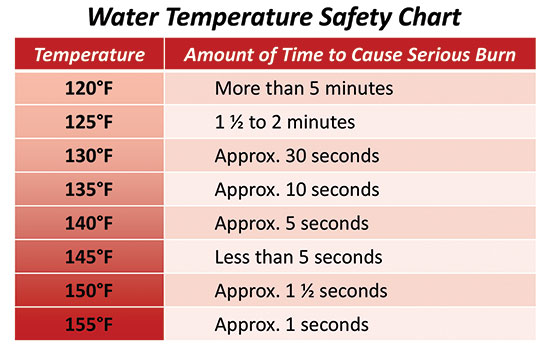
Image courtesy of Powers, a Watts brand
At the point of source, hot water is set at a higher temperature and then delivered to a variety of point-of-use elements such as faucets, showerheads, laundry, and laboratory equipment. A well-designed system will mix hot water from the boiler with cold water to the selected temperature. At the point of use, the temperature of the water is controlled through thermostatic, pressure-balanced, or combination valves to the required set-point temperature.
Pressure balanced valves (most common in showers) do not automatically limit outlet temperatures should the supply temperatures dramatically increase or decrease. This can provide a potentially dangerous water supply to the end user in the building. Further, to prevent users from adjusting the valve beyond a safe operating temperature, all valves require the installer to set the high temperature limit. However, to accommodate future changes in the hot or cold-water temperature or in replacement or new fixtures, only pressure-balancing valves require a manual reset of the temperature limit.
Mechanical thermostatic mixing valve (TMVs) have been in use for the past 100 years and have changed little, short of adding paraffin to the actuator instead of liquid, chemical filled, or bi-metal coils. These valves are most reliable under ideal conditions. These include:
- Equal pressures or under 20 percent differential across inlets;
- Field installation according to diagrams and proper balancing;
- Properly sized valves and recirculation pumps as well as appropriately placed checks;
- Implementation of a regular maintenance program; and
- High quality water, free of scale and debris.
Thermostats (paraffin, bi-metal, ether-filled) in TMVs respond to temperature changes. In comparison, a digital control module responds in near real time to pressure and temperature. Gauges in TMVs are analog, which are placed at water inlets and outlets. New digital systems provide full color, digital displays with accuracy to 1/10” of a degree. However, a mechanical TMV is limited by minimum flows and subject to temperature creep during low and zero demand periods. As temperature rises or “creeps” overnight in an essentially closed-loop system, this may result in temperatures that can cause scalding when the first fixtures are opened in the morning. Lastly, TMVs cannot be connected to Building Automation Systems and therefore cannot be managed off-site or provide data for green building systems.
One of the greatest benefits of new digital units is that they provide temperature stabilization within +/- 2 degrees F, in comparison to TMVs temperature swings that are of as much as +/- 7 degrees F (valves >40 gpm capacity). The inefficient use of hot water can mean an increase of large percentages in an overall energy budget for hotels, hospitals, institutions, or large commercial buildings. Energy and water savings can be achieved by controlling hot water temperature swings.

Photo courtesy of Powers, a Watts brand
The components of a digital water mixing and recirculation station can be easily replaced.
Smart System Design Components
A digital water mixing and recirculation station can be integrated into a Building Automation System to allow facility managers control and visibility of their domestic hot water delivery. These units can control the entire tempered water recirculation loop safely and efficiently. Some of the more advanced technology can be configured in the field and do not require the use of a laptop or special software.
A manufactured system with integrated components is connected to any commercial boiler and mounted on small 2’ x 3’ plumbing grids. New systems are “plug and play,” and critical components can be easily replaced. An engineer can specify the recirculation pump make and model based on the specific requirements of a given project. Engineers can also provide system requirements. Other components include:
- Control module connected to BAS systems;
- Mixed outlet temperature and pressure sensors;
- Electronically activated valve;
- Hot water supply and return temperature and pressure sensors;
- Hot and cold water temperature and pressure sensors; and
- Flow sensors can also be added to measure the mixed and return flow of water as well as energy consumption.
The systems should be selected in conjunction with compatible plumbing fixtures to maximize water savings such as thermostats and valves at the point of use. Systems can be commissioned at the job site with direct field data input rather than factory settings that are more difficult to change.
Control modules are the intelligence of these systems. They should be able to be viewed on a home screen, and some of these systems can display as many as 196 combinations of critical system data, including mixed outlet temperature. Variables that can be monitored include pressures, temperatures, flows, and energy. Specific data can include:
- Hot and cold supply inlet temperature;
- Hot and cold supply inlet pressure;
- Mixed outlet temperature and pressure;
- Mixed and return outlet flow rate;
- Energy consumption; and
- Return temperature and return pressure.
The facility operator is able to access this data from a central data source, at the controller or through the Building Automation System. Error codes help to troubleshoot problems. Common adjustments and data flow allow for predictive temperature stability. When there is instability in the system due to low flows at the hot water inlet and/or cold water inlet and temperatures are fluctuating, the controller anticipates this problem and turns on the pumps to provide stability.
Energy is saved through the ability to detect when the system pump can no longer generate flow. The controller simply turns off the pump when the pressure exceeds the pump head. The pump is turned off until a minimum “off time” has elapsed and the system pressure drop across the pump is below the maximum pump head. It also turns the pump off when the desired recirculation temperature is attained; it is turned back on if the temperature falls below a pre-set limit.
Temperature “creep” occurs when there is little or no demand for hot water in a facility. This typically occurs during overnight hours when user demand is low. Mixed outlet temperature may rise when the internal hot water bleed-over exceeds the total demand on the system, potentially creating an elevated temperature condition. These units provide a commercial grade, electronically controlled valve that provides near 100 percent internal shut-off of hot water (no bleed-over) during zero-demand periods, eliminating the potential for temperature creep. This eliminates the need for a circuit setter (balancing valve) or automatic balancing valve, simplifying the overall plumbing system.
The actuators in these units have internal capacitors to position the valve to full cold water upon any power failure. There are also overrides that allow manual adjustment of the valve to a tempered water position at the station during a prolonged outage. Once power is restored, the controller returns the system to the previous setting. If the outage occurred during a sanitation mode, the facility manager can reprogram the valve as a safety precaution. Actuators should be located outside the actual mixing valve to protect the controls from water leakage.
Digitally controlled, industrial-grade, lead-free, electronic valve modules respond in near real time to pressure, temperature, and flow. Plumbing fixtures and fittings specified after 2014 should meet National Sanitation Foundation, NSF 372 standards as in compliance with Section 1417.
A digital water mixing and recirculation station can be encased in enclosures constructed for either indoor or outdoor use. An enclosure can protect components from physical damage due to falling objects or from exposure to indoor flooding. If the system is on the exterior, an enclosure will protect the units from ice build-up, rain, snow, or sleet. Enclosures are used to secure controller modules to limit access to authorized personnel.
High-Performance and Safety Standards Compliance
As with any specified system, there are numerous standards that high-performance equipment must meet. Digital water recirculation and mixing stations exceed performance values for many of these standards, increasing the ability to conserve water and save energy. ASSE 1017 – 2009 requirements for Temperature Activated Mixing Valves or Hot Water Distribution Systems requires that certified products must perform as follows:
- Tested at 50 percent of valves flow at a 10 psi differential;
- Increase hot water temperature 25 degrees F within 5 minutes, 5 degrees F/ 1 minute; and
- Must hold +/- 7 degrees F (valves >40 gpm)
By incorporating electronic valves, fast temperature sensors, and digital controls, new systems can sample water temperature ten times per second and make necessary adjustments to stabilize mixed outlet set point temperature to within +/– 2 degrees F.
Other applicable ASSE standards include the following:
ASSE 1016 covers the delivery of water at the individual shower fixtures that are adjusted and controlled by the user. Therefore, it addresses very precise and immediate temperature regulation requirements. This standard covers three types of valves: Pressure Balancing, Thermostatic, and Combined Pressure Balancing/Thermostatic.
ASSE 1070 covers control of maximum temperature to a fixture or group of fixtures such as sinks, lavatories, or bathtubs. The device may either be the final temperature regulation or have water further tempered downstream with the addition of cold water.
New construction advanced building commission required by USGBC LEED v4 and other green rating systems require verification of building performance and the inclusion of recommissioning management manuals. Throughout the life of a building, the domestic water supply is the building system that needs to be carefully monitored to prevent the accumulation of harmful bacteria such as Legionella. OSHA publishes guidelines and recommendations for the control of Legionella. Hot water at the point of source should be maintained at 140 degrees F and frequently re-circulated throughout a system which “steps” down the temperature to prevent scalding at the point of source. ASHRAE Standard 188P lists requirements for sanitation modes that can disinfect contaminated hot water systems. One effective method for emergency disinfection of contaminated hot water is the implementation of a thermal shock treatment using the following procedure as recommended by the Legionella Prevention Association:
“ASHRAE Standard 188 8.1.5.1.1 An effective method for emergency disinfection of contaminated hot water systems is thermal shock treatment to be implemented using the following procedure:
- Water temperatures shall be maintained at 71 to 77 degrees C (160 to 170 degrees F) while progressively flushing each outlet in the system BSR/ASHRAE Standard 188P
- A flush time of thirty minutes shall be attempted. The intent is to provide thermal eradication for as long as possible up to thirty minutes.
- Sanitization modes that conform to this standard can be quickly initiated in case of suspected water contamination. The digital controls on these water mixing and recirculation stations can also be set to provide regular maintenance by facility managers to prevent Legionella contamination.
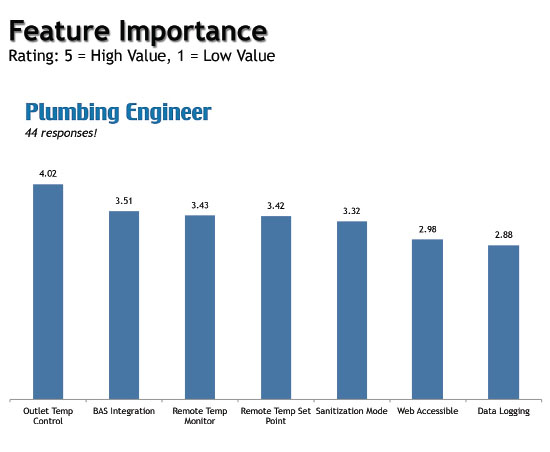
Image courtesy of Powers, a Watts brand
Important features of digital mixing valves as rated by plumbing engineers.
Choosing Electronics for Safety, Accessibility, Controls, and Measurements
Surveyed by a large water technology company, plumbing engineers rated the most important features of digital mixing valves. Out of 44 responses, the following, in order, were the reasons to select a digital instead of a mechanical plumbing system:
- Outlet temperature controls
- BAS integration
- Remote temperature monitoring
- Remote temperature set points
- Sanitation mode
- Web accessibility
- Data logging
Thirty–two percent of the engineers specified digital mixing valves to support their goals in energy management. Twenty-five percent chose them because of advance performance capabilities that included outlet temperature controls and the reduction in temperature swings from +/- 7 degrees F to +/- 2 degrees F. Safety, liability, communications were also major factors considered by plumbing engineers when specifying a hot water distribution system.
Project Types – All Buildings and Green Buildings
In 2013, the American Institute of Architects (AIA) formally recognized sustainability as being central to the design of buildings that protect the public’s health, safety, and welfare. According to the AIA, “sustainable design is achieved through an integrated design and delivery process that enhances the natural and built environment by using energy sensibly with a goal toward carbon neutrality; improves air and water quality; protects and preserves water and other resources; and creates environments, communities, and buildings that are livable, comfortable, productive, diverse, safe, and beautiful.”
All buildings need to have safe water supplies designed and maintained throughout the life of the building. As the population grows, urban density increases and larger populations are being housed in both commercial and institutional structures. The characteristics of many of these project types provide a basis for choosing plumbing systems with value-added features, particularly those that enhance data collection.
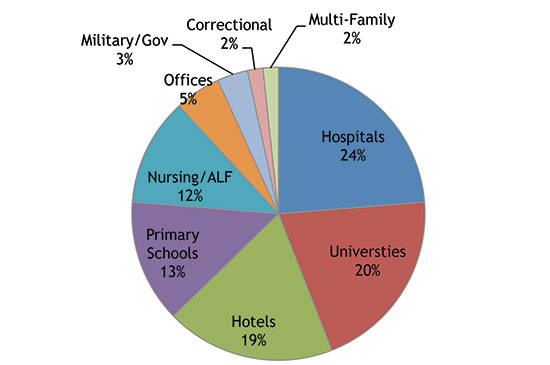
Surveyed plumbers and engineers specify digital mixing systems in these types of buildings.
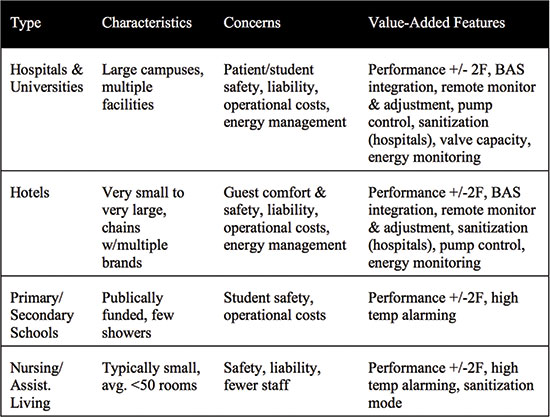
Images courtesy of Powers, a Watts brand
Value-added features of automated hot water mixing and recirculation systems.
All buildings are living machines with the unique system and biological relationships of organisms. Energy, water, and air quality are part of the many building systems that professionals need to integrate, maintain, and celebrate by design. New technology is supporting the movement to develop smarter green buildings. New green building credits such as found in LEED v4 require more documentation and measuring of system inputs. The Building Owners and Management Association recommends high-performance buildings use BAS monitoring systems and challenges building owners to reduce their use of natural resources, non-renewable energy sources, and waste products. New technology for automating plumbing systems allows managers to measure, meter, and maximize water use. These new plug and play components are designed both for new construction as well as for renovations.
As California and other parts of the Western U.S. face extreme drought, researchers, designers, and manufacturers race to find the most effective way to save water as well as save energy. Advances in digital water technology provide new opportunities and approaches to safer and more efficient water delivery systems for high-performance buildings.
Endnotes
1. Survey: Scalding Water Found in Nearly 90% of Hotel Rooms; Legionella Also a Risk
2. http://www.hotel-online.com/News/PR2004_4th/Dec04_ScaldingWater.html. August 19, 2015
3. Fast Facts. August 20,2015
4. Outbreaks. August 20, 2015
5. Energy consumption in homes by end uses.. September 8, 2015
6. Table B24
7. Managing Energy Costs in Hospitals. August 20, 2015
8. Indoor Water Use Calculator. August 23, 2015
9. Indoor Water Use Reduction. August 23, 2015
10. Summary Of The Reduction Of Lead In Drinking Water Act. August 23, 2015
11. IBID
12. www.ASSE-plumbing.org
13. https://www.osha.gov/dts/osta/otm/otm_iii/otm_iii_7.html. August 23, 2015
14. Section 8.1.Water treatment, Sanitizing, & Management System. August 23, 2015
15. AIA Continuing Education System: Sustainable Design. August 19, 2015
Celeste Allen Novak, FAIA, LEED AP BD+C, is an Ann Arbor, Mich., architect who specializes in sustainable design and planning. She is the author of “Designing Rainwater Harvesting Systems: Integrating Rainwater Into Building Systems.”
 |
Powers, a Watts Regulator Company, provides distribution, point-of-use, and emergency water mixing and temperature solutions used in residential, commercial, and institutional applications. Powers’ T/P technology provides superior protection against temperature and pressure changes. www.powerscontrols.com |
LEARNING OBJECTIVES
- Identify the challenges and dangers inherent to hot water delivery systems in buildings.
- Discuss digital advances and water mixing and recirculation stations that maximize burn protection while minimizing the health risks for water borne bacteria in high performance commercial and institutional facilities.
- Review components and codes that determine performance standards for a safe and efficient hot water delivery system.
- Specify an integrated hot water delivery system that can be tied into a building automation system to meet green codes for measurement and verification.













